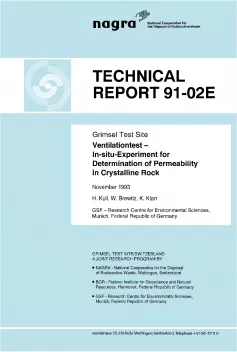
Technical Report NTB 91-02
Grimsel Test SiteVentilation testIn-situ-Experiment for Determination of Permeability in Crystalline Rock
The Ventilation Test is an in situ test aimed at determining the mean permeability – macropermeability – of a hydrogeologically representative underground rock volume with relatively low water inflow rates.
Measurements are made of the natural rate of water inflow and hydraulic head distribution in the near vicinity of a defined section of the drift, taking care not to interfere with the flow conditions in the adjoining rock by drilling numerous exploratory boreholes. The parameters required for the hydraulic evaluation of the rock section under investigation are determined by means of structural geological mapping of the drift surface taking into consideration the exploratory boreholes in the remaining drift system.
In order to define the large-scale permeability of the crystalline rock, a test drift 70 m long at the Grimsel Test Site was separated into two measuring chambers and water inflow was measured under alternating ventilation and climatic conditions.
The hydraulic gradient, which is also required for permeability calculations, was obtained through pressure measurements in two observation boreholes located parallel to the drift.
With the aid of borehole tests and petrophysical laboratory investigations, further procedures were employed in order to determine the permeability, the aim being to verify the results from the ventilation test.
In addition, the hydraulic flow field was analysed by numerical modelling based on the measure data obtained.
This report describes the tests performed from 1985 to 1990 (phases 1 and 2) and the corresponding test procedures. On the basis of the measured values obtained in situ, a site-specific flow model is being developed for the jointed crystalline rock in the ventilation test area of the Grimsel Test Site.
